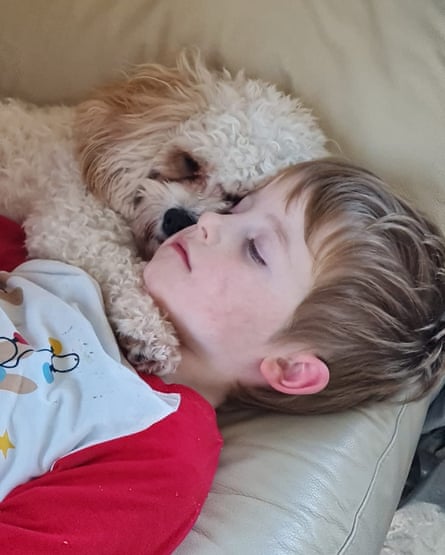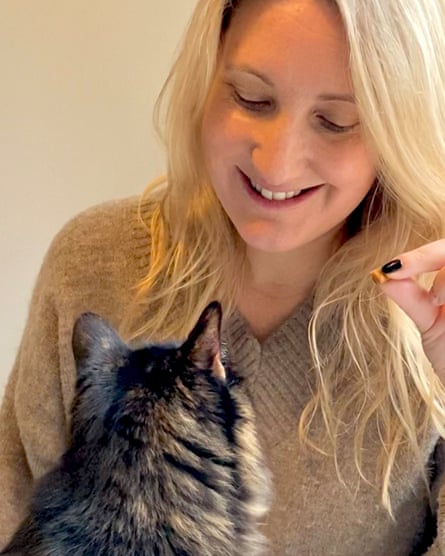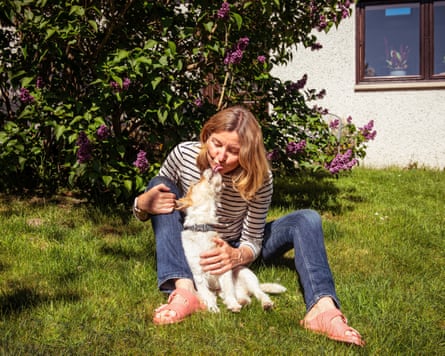I am lost in Morris’s eyes. They are brown, almond-shaped and fringed by impossibly long lashes. He looks back at me, softly blinking occasionally, and then reaches out his tongue and licks my cheek, just once.
I’ve been depressed lately, and while I’ve received compassion and support from many dear people, Morris, my 10-year-old terrier, has been one of the greatest sources of comfort. With that reassuring lick, that steady gaze, he’s conveying a message: “It’s OK. Everything will be all right.”
Or is he? Could the look actually be saying: “Those biscuits in the tin … Fancy getting me one?” Was he merely licking a fleck of mayonnaise off my cheek?
Dr Jon Bowen, a behavioural consultant at the Queen Mother hospital for animals in Hertfordshire, waves my doubts away. “I’m sure your dog was showing empathy and support,” he says. “It’s part of why our mutual bonds with them are so powerful.” He also tells me that the close eye contact we shared would have released oxytocin, the bonding hormone – in both of us.
A 2021 study found that 80% of dog owners felt that their pet helped them get through tough times, and I’ve recently spoken to many people who felt the same. Sally Bayly, a yoga teacher from Rye in East Sussex, told me that when her husband, Michel, died in 2020, Lola, their black labrador, became extra attentive to her and her two sons. “It was as if she’d lost one of her pack and was determined not to lose any more,” she said. “Whenever one of us is feeling down, she’ll come over and lie near us, put her head close to us, or lick our hands, face, even clothes.” Lola accompanies Bayly to classes, where she plays an important role: “During relaxation, she walks around quietly, standing near people or sniffing them until they settle. She only lies down on her blanket when she feels everyone is totally relaxed. This helps me to know, too.”
Margaret Walsh, a health and safety manager in the west of Ireland, told me how her cavachon helps her autistic son through difficult moments. “Conor rocks when he’s overstimulated, and as soon as Missy becomes aware of his distress she will jump on his lap, which helps them both relax.”

Not everyone in the scientific community is willing to recognise such behaviour as empathy, however. One recent study concluded: “It appears unlikely that dogs are capable of sympathy or empathy.”
“There is a belief in some quarters that certain emotional and cognitive capacities, like being empathic, are a human preserve,” says Dr Karen Hiestand, a lecturer in veterinary and animal ethics at the Royal Veterinary College, Hertfordshire, whose research centres on human-animal relationships. “Attributing such qualities to other species is considered anthropomorphism or ‘bad science’.”
If our pets’ seemingly caring behaviour isn’t empathy, then what is it? One theory is that it could be driven by curiosity: why is my human not getting out of bed/making those strange sobbing sounds?
Then there’s what’s known as “emotional contagion”, whereby witnessing an emotion in another “infects” the observer with the same emotion. (This is easily seen in young toddlers – one begins to cry and soon the room is full of crying infants.) Emotional contagion doesn’t require any understanding of why someone is feeling what they’re feeling, or motivate support. That would be what Hiestand calls “top-shelf empathy”, “where there’s a cognitive component – a thought process that says: I know how you feel, and I’m going to try to do something to help.”
One of the ways this has been investigated in nonhuman animals is by replicating studies originally designed to test toddlers. The parent/owner feigns some kind of sudden distress and the infant/animal’s response is monitored – will they simply carry on with what they were doing? Will they get excited? Try to offer comfort?

One such study sought to distinguish between emotional contagion and higher empathy by bringing a stranger into the mix. When the owner cried, the majority of dogs showed empathic concern and comfort offering: they approached them slowly and gently – some nuzzled or put a paw on their owner, a couple made whimpering noises.
But what about the stranger? If they were only experiencing emotional contagion, the dog would go to their owner for comfort when the stranger cried. If empathy was at work, however, then the dog would approach the crying stranger and seek to comfort them. This is what happened: the dog noticed the stranger’s distress and went to them to offer comfort.
Hiestand’s recent research adopted a similar experimental protocol – owners faked a sudden injury. But her study also included cats.
A self-professed cat person (“till I die,” she says) Hiestand believes our feline friends are widely misunderstood – and unfairly compared with dogs.
“While we share our lives and homes with both, they are completely different, evolutionarily speaking,” she says. “Dogs are highly social, group-living animals who have co-evolved with us for at least 40,000 years. Their ability to read us is huge. Domestic cats evolved from a completely solitary ancestor – the African wildcat – and have lived alongside us for far less time; any sociability they display is a domestication effect, not an inherent part of them.” By this token, a display of empathy from a cat in Hiestand’s experiment would be quite extraordinary.

So what happened? Like dogs, the cats did change their behaviour in response to the feigned injury. “They stopped what they were doing. They looked at the owner more, though did not necessarily approach them. And they showed signs of stress, typically grooming a paw. Whether that’s empathy, or whether it’s ‘something weird is happening to this important resource in my world, so I’ll keep an eye on them’, it’s still significant.”
Anne Hadley, a PhD student from Brighton, is convinced that her cat Harry is responsive to her emotional state. “When I am distressed, he seems to sense my need for comfort without me seeking him out, and he provides it in the only way he knows – snuggling up to me and purring,” she says. “He also loves being around me when I meditate, lying as close to me as possible.”
Does Hiestand think her cat, Hermione, understands her? “I don’t know if she understands me, but recently she got beaten up by a neighbour’s cat and sustained some nasty injuries,” she says. “The normal thing for a cat that’s in pain or stressed is to go away and hide. But she came to me for comfort and support. When a cat behaves that way, it is motivated solely by their relationship with you, it’s not an innate response. She wanted to be close to me, and that made me feel amazing.”
This raises an important point. If believing that Morris is taking extra care of me helps me feel better, then his actions are of value, regardless of what motivates them. Hiestand agrees. “The participants in my study all reported increased bonds with the animals they believed were able to empathise with them, which provided great support.”
Regardless of whether cats and dogs really care about our feelings, the fact that they can read our emotions so accurately in the first place is in itself remarkable.
In a recent Seed Talk called The Psychology of Dogs, Bowen explains how dogs have learned that humans need to be looked at differently from dogs in order to read emotions. “In humans,” he says, “emotions are more clearly readable on the left side of the face. When we try to read each other’s feelings, we tend to focus more – and for longer – at the left side of the face due to this asymmetry”. But dogs don’t have one side of the face more expressive than the other. “When they look at each other, they don’t focus on the left side of the face because there’s no need to. But when they look at us, they do,” says Bowen.

Eye-tracking studies – which use technology to follow the focus of a subject’s gaze – show something similar. If it’s another dog they’re looking at, a dog’s first port of call will be the ears, then the mouth and eyes; but if it’s a human, they look first at the frontalis muscles (that wrinkle the forehead or raise the eyebrows), then the cheeks (which work hard when we smile) and eyes.
Cats, too, recognise the emotions represented by different human expressions and tones of voice. They have also learned to use their voices as a way of communicating what they are feeling – miaowing is primarily directed at humans, not other cats.
“Harry is the most vocal cat I have ever known,” says Hadley. “He leaves you in no doubt about his feelings. His miaows vary from chatty to purry, to a demanding no-nonsense miaow and a tragic wail.”
As a woman and a cat owner, Hadley represents the cohort of people who fared the best in a 2020 study by the University of Milan, which sought to test how adept people were at identifying the emotions associated with different cat miaows. Most people failed miserably.
Given our long, shared history, you’d think we’d do better at reading dogs – but we’re pretty hopeless at that, too.
In research by Dr Holly Molinaro, from the Canine Science Collaboratory at Arizona State University, the majority of her 300 participants could not reliably gauge whether a dog in the video footage they were shown was happy or sad.
Molinaro filmed a dog encountering a variety of situations: for example, being offered a treat, seeing a cat, or facing a man holding a leash or brandishing the vacuum cleaner. In the first instance, she only showed participants footage of the dog itself. Then she showed them the whole video. Given this new contextual information, they were much more forthcoming about whether the dog was happy or sad, calm or agitated. However, Molinaro noticed that they judged the dog’s emotions not on his behaviour but on the situation. “If he was in a positive scenario, they assumed he was happy; if it was negative, they assumed he was not happy,” she says.
To test this out, Molinaro edited the video, swapping around the dog and background. For example, people were shown footage recorded when the dog was staring down the barrel of the vacuum cleaner, but in which he now appeared to be getting shown his leash. Despite having described him as feeling “bad and agitated” in the first instance, they now rated him “happy and calm”. “The results clearly showed that people judged the dog’s emotions not on his behaviour, but on the context,” Molinaro says.
Even worse, when those who’d watched the doctored footage were asked what information they’d used to judge the dog’s emotions, they chose “context” the least, claiming to have observed the dog’s actions and demeanour. “We think we’re looking at the dog but we’re not.”
Hiestand points out that even when we do look at our pets’ expressions, we often misconstrue what we see.
“The idea that animals feel guilty when they’ve done something ‘bad’ is widespread, but it’s incorrect,” she says. “When you get home and they’ve ripped up a cushion, what you’re seeing isn’t guilt – it’s fear. They are picking up that you are angry or upset.”
Part of the problem is that we can’t help imagining how we would feel in a given situation and projecting our own feelings on to them. “It’s so easy to do,” says Molinaro, admitting that despite her research, she still catches herself doing it with her cat.
While our failure to read our pets’ feelings can, on occasions, be disastrous (Hiestand calls the recent rise in dog bites an epidemic), the consequences are generally less serious: a dog having to endure a hug, when research shows the vast majority don’t enjoy it; or as Hadley confesses, a longsuffering cat who, as a child, she would dress up in doll’s clothes – and “who never once scratched or protested”.
But that doesn’t mean we shouldn’t try to do better.

“There’s an assumption that because we love our pets, their lives are good,” says Hiestand. “That is categorically not the case. We need to be mindful of ignoring their needs. We need to get to know them, not just as a dog or a cat but as an individual.”
Bowen agrees. Over the last few years, he has used his considerable knowledge and skill to address an important question. What makes Wisley tick?
Wisley is a black labrador who, says Bowen proudly, is the best dog in the world. (Well, that’s a coincidence, I say …)
“He likes playing Frisbee. But what exactly about the game does he like? Is it the chase? Is it catching? Does he like chasing and catching other objects – or only a Frisbee? By observing him and pinpointing the moment he enjoys the most, I’ve learned what he likes and can fulfil it,” he says. “Knowing how to make your dog happy makes you happy.”
I’d always liked to think I was pretty good at reading Morris. He has this way of talking with his eyes: I want a drink. I need to go outside. Can you two go to bed now? I’m tired.
But writing this piece has given me paws (sorry) for thought. I’ve begun to notice that while he likes to come to me and sit very close when he senses I’m upset, he isn’t comfortable with me forcing such contact – say, picking him up and carrying him to where I’m going. And, no, he isn’t keen on being hugged. He‘ll tolerate it, but after a few moments he’ll get down and sidle off.
In future, rather than basing my interactions with Morris around what I want, I’m going to make the effort to be more mindful of how he is feeling. After all, he is the best dog in the world.

 2 months ago
63
2 months ago
63

















































